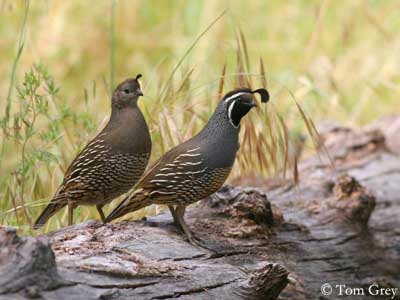
California Quail
Callipepla Californica
Galliforme Order – Orontophoridae Family
BIOMETRICS:
Length: 23-27 cm
Wingspan: 36-41 cm
Weight: M: 176 g – F: 162 g
DESCRIPTION:
California Quail is a plump bird with strange and beautiful moving feathers on the forecrown.
This handsome bird is the California’s state bird.
Fr: Colin de Californie
All : Schopfwachtel
Esp : Colín de California
Ital: Colino della California
Nd: Californische Kuifkwartel
Russe: Калифорнийская куропатка
Sd: Kalifornisk tofsvaktel
Photos de Tom Grey
Tom Grey's Bird Pictures
Texte de Nicole Bouglouan
Sources:
HANDBOOK OF THE BIRDS OF THE WORLD Vol 2 by Josep del Hoyo-Andrew Elliot-Jordi Sargatal - Lynx Edicions - ISBN: 8487334156
BIRDS OF THE GREAT BASIN – by Fred A. Ryser - Univ of Nevada Pr -ISBN: 0874170796
All About Birds (Cornell Lab of Ornithology)
What Bird-The ultimate Bird Guide (Mitchell Waite)
Wikipedia (Wikipedia, The Free Encyclopedia)

Adult male has rich blue-grey and brown plumage.
Upperparts are grey on back, rump and tail. The rounded wings are brown.
On the underparts, breast is blue-grey. Upper belly is buff, lower belly is red-brown and sides are white. These three parts show conspicuous scaled pattern with black-edged feathers. Flanks are brown streaked white. Undertail coverts are buffy-white and undertail feathers are grey.
On the head, crown is red-brown, bordered by black and white stripes. Forehead is paler brown, extending over the eye and down to ear-coverts and head sides. Face, chin and throat are black bordered by white stripe joining the rear of the eye. Nape is black, finely spotted white, extending to the neck sides.
We can see a conspicuous long topknot of black feathers projecting forwards from the forecrown.
The short bill is black. Eyes are dark brown. Legs and feet are grey.
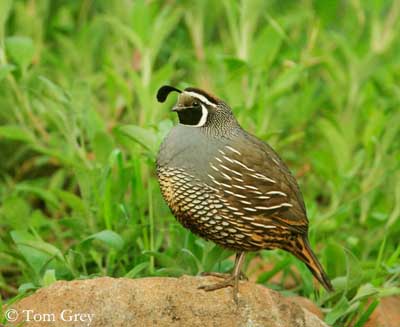
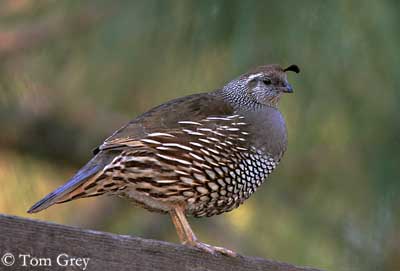
Female is duller. She has greyish with fine black streaks head and throat. The topknot is shorter and she lacks the bold facial pattern of the male.
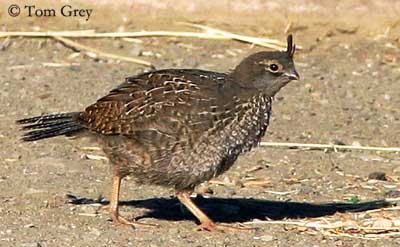
Immature shows buff tips on primary coverts, and topknot is shorter.
Eight subspecies are recognized and differ in tones of greyish and brownish on back.
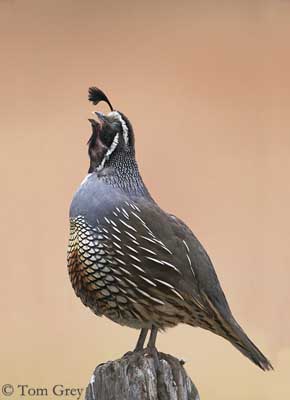
VOICE: SOUNDS BY XENO-CANTO
California Quail utters several kinds of vocalisations such as shrieks and chipping sounds, and even some whistles.
Most of the calls are related to courtship displays of males, but also to feeding behaviour and threats.
We can hear varied grunts and cackles, and the famous loud, emphatic “ka-kah-ko”, known as “chi-CA-go”!
HABITAT:
California Quail usually frequents brushy chaparral, live oak canyons, brushland, desert, grassland, cultivated areas, evergreen forest and edges, but it also may be found in city parks and suburban gardens.
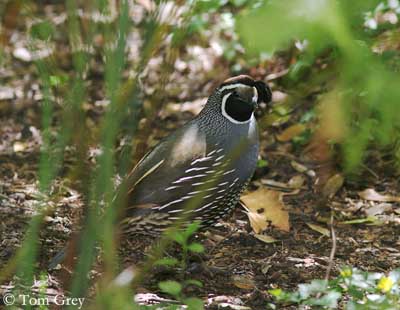
RANGE:
California Quail is sedentary within its range. Its original range is SW United States, but the species has been introduced to Chile, Argentina, New Zealand, Australia (King Island), Hawaii and British Columbia.
BEHAVIOUR:
California Quail feeds on seeds and bulbs of several plant species (Lupinus, Lotus, Quercus…) and barley. It feeds by scratching in litter. It also plucks leaves from vegetation. It forages on the ground where it walks or runs easily. If disturbed, it prefers to escape by running, but it also explodes into short flight.
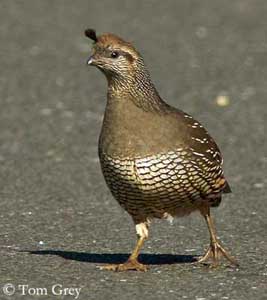
The species is very gregarious, and the birds forage and roost together on coveys almost all year round.
When they are foraging, if they lack the visual contact, they utter continuously their “ut-ut” call to maintain oral contact between them.
If the group becomes scattered, they give they loud typical “cu-ca-cow” call. And if a member of the covey becomes isolated for long time, it often gets into a panic and utters loudly this call.
The groups have “sentinels” in order to survey the potential predators. When the danger is extreme such as aerial attack by raptor, they give “kurr” calls. But adult males take turns as sentinels, perched on high points, tree branches, posts or roofs.
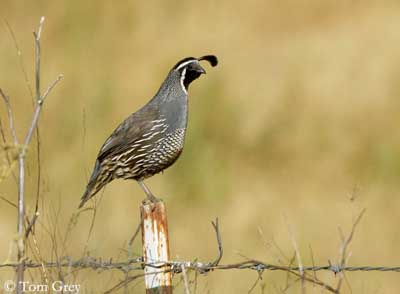
Unfortunately, during the hunting season, hunters locate first the sentinels and then find easily the covey.
Courtship behaviours of these birds are poorly known, but they appear to be monogamous. The displays include the use of the bright coloured parts of the head or the body, by dropping or spreading the wings, and frontal and lateral postures by males.
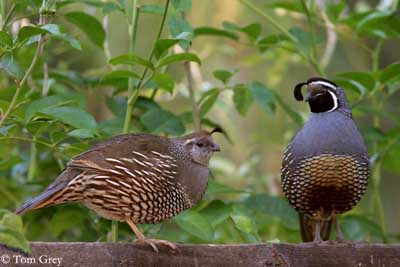
California Quail groups perform dust baths in sunny areas, which are included in their daily activities. These baths create circular markings in the soft soil.
FLIGHT:
California Quail flies by explosive bursts of speed over short distances.
The flight is short but strong, with rapid wing beats.
REPRODUCTION:
Breeding season occurs from early April (in S) or May-June (in N), to July-August.
The nest is a depression on the ground, a shallow scrape lined with grass.
California Quail breeds in shrubby areas and open woodlands. The nest is usually protected by shrub, tussock or other cover.
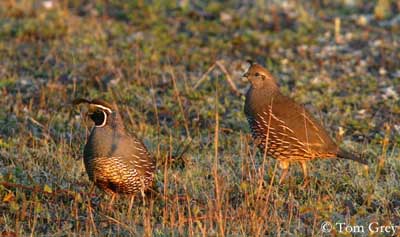
Female lays 13-17 creamy-white eggs with weak brown markings. Clutch may be more important in communal broods. Incubation lasts 22-23 days by female. Chicks are reared by both sexes.
According to the conditions, female may lay a second clutch.
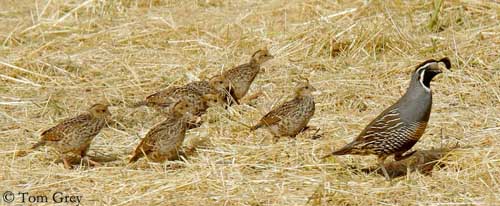
DIET:
California Quail feeds on seeds and bulbs of several plant species. It forages on the ground by scratching.
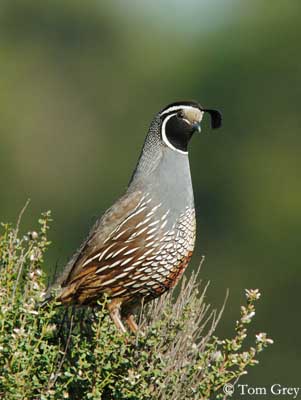
PROTECTION/THREATS/ STATUS:
California Quail populations are safe, in spite of heavy hunting in W United States. They also are vulnerable to changes in their habitat, and declines are observed since 1960.